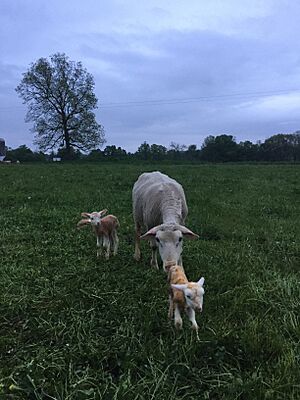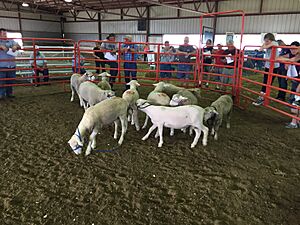Polypay facts for kids
The Polypay is a special kind of sheep breed. These sheep are white and medium-sized, usually weighing around 65 kg (about 143 pounds). They are also "polled," which means they naturally don't have horns. The Polypay breed was created in the 1960s at the U.S. Sheep Experiment Station in Dubois, Idaho.
Polypay sheep are known for being very good mothers and having many lambs. They are also a "dual-purpose" breed, meaning they are raised for both their meat and their wool. Each year, a Polypay sheep can produce about 4.2 kg (around 9 pounds) of wool. Their lambs are usually ready to be weaned from their mothers at about 120 days old.
How the Polypay Sheep Was Created
Dr. Clarence V. Hulet, a scientist at the U.S. Sheep Experiment Station in Dubois, Idaho, had big plans when he started creating the Polypay sheep. He wanted this new breed to be amazing in five key ways:
- Have many lambs over their lifetime: This means ewes (female sheep) could have lots of babies during their lives.
- Produce many lambs at a young age: Ewes should be able to have a good number of lambs even when they are only one year old.
- Lamb more often than once a year: Most sheep only have lambs once a year, but Dr. Hulet wanted Polypays to have lambs more frequently.
- Grow lambs quickly: The baby lambs should grow fast.
- Have good quality meat: The meat from these sheep should be tasty and good for eating.
To create the Polypay, Dr. Hulet used four different sheep breeds, each bringing special qualities:
- The Finnsheep were chosen because they have many lambs, can have babies at a young age, and have shorter pregnancies.
- The Dorset sheep were picked for being excellent mothers, having good meat quality, being able to have babies early, and having a long breeding season.
- The Targhee sheep contributed their large body size, long breeding season, and good quality fleeces.
- The Rambouillet sheep were included for being tough, able to adapt to different places, producing a lot, and having good quality fleeces.
In 1968, Dr. Hulet made the first crosses. He bred Finnsheep with Rambouillet sheep, and Dorset sheep with Targhee sheep. The first lambs from these crosses were born in 1969. Then, in 1970, he combined all four breeds to create the first Polypay sheep.
Seeing how promising the new breed was, Dr. Hulet gave it the name "Polypay" in 1975. The name comes from "poly," meaning "multiple," and "pay," meaning "return on investment." It also means the sheep can give more than two valuable "crops" each year: two groups of lambs and one wool crop. The American Polypay Association was later started in 1980.
Polypay Sheep Today
The people who raise Polypay sheep are very active and work hard to make the breed even better. The American Polypay Association has about 100 members, and around 1,500 Polypay animals are registered each year.
In 1987, a program called the National Sheep Improvement Program (NSIP) began, and the Polypay breed was included. Through this program, breeders have made the Polypay's good qualities even stronger. There are nearly 14,000 Polypay animals in the NSIP registry today. Each year, there are special sales for Polypay sheep in places like Sedalia, Missouri; Spencer, Iowa; and Wooster, Ohio. These sales look at how the sheep are built and also use special breeding values to show how good their genes are.
What Makes a Polypay Sheep a Polypay?
To be officially registered as a Polypay, a sheep must meet certain requirements. It needs to be born from registered Polypay parents, or from parents that have the right mix of the four original breeds (Rambouillet, Targhee, Dorset, and Finnsheep).
Here are some other important things a Polypay sheep must have:
- It must be healthy and not have any major physical problems.
- Its wool should not grow over its eyes, which would make it hard to see.
- Its body should be smooth, without extra skin folds around the neck.
- Its wool fleece must be white, and less than 10% of the hair on its head and legs can be black or brown.
- Its wool should not be too coarse or rough in certain areas.
- It must be "polled," meaning it has no horns. Female sheep (ewes) should not have small horn-like growths called scurs. Male sheep (rams) should ideally not have scurs either.
- Its front teeth must touch the dental pad in its upper jaw.
Polypay ewes are usually able to have lambs when they are one year old and can often raise twins. Adult ewes typically weigh between 150 and 200 pounds. Adult Polypay rams are larger, weighing between 240 and 300 pounds. For a Polypay to be shown or sold at an event, it should have been born as a twin or more. Also, any ewe shown in a "Yearling Ewe Class" must have already had lambs.
Even though Polypays are a general-purpose breed, they are especially known as a "maternal breed." This is because they have many lambs, can breed at different times of the year, become fertile early, produce a lot of milk, and are good mothers. When Polypays are bred with other sheep breeds that are good for meat, their lambs often show "hybrid vigor." This means the lambs grow faster and have better meat quality.



